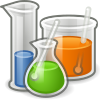| Part of a series on |
| Continuum mechanics |
|---|
| Part of a series on |
| Chemistry |
|---|
 |

In chemical analysis, chromatography is a laboratory technique for the separation of a mixture into its components. The mixture is dissolved in a fluid solvent (gas or liquid) called the mobile phase, which carries it through a system (a column, a capillary tube, a plate, or a sheet) on which a material called the stationary phase is fixed. Because the different constituents of the mixture tend to have different affinities for the stationary phase and are retained for different lengths of time depending on their interactions with its surface sites, the constituents travel at different apparent velocities in the mobile fluid, causing them to separate. The separation is based on the differential partitioning between the mobile and the stationary phases. Subtle differences in a compound's partition coefficient result in differential retention on the stationary phase and thus affect the separation.[1]
Chromatography may be preparative or analytical. The purpose of preparative chromatography is to separate the components of a mixture for later use, and is thus a form of purification.[2][3] This process is associated with higher costs due to its mode of production.[4][2] Analytical chromatography is done normally with smaller amounts of material and is for establishing the presence or measuring the relative proportions of analytes in a mixture. The two types are not mutually exclusive.[5]
- ^ McMurry J (2011). Organic chemistry: with biological applications (2nd ed.). Belmont, CA: Brooks/Cole. pp. 395. ISBN 9780495391470.
- ^ a b González-González M, Mayolo-Deloisa K, Rito-Palomares M (1 January 2020), Matte A (ed.), "Chapter 5 - Recent advances in antibody-based monolith chromatography for therapeutic applications", Approaches to the Purification, Analysis and Characterization of Antibody-Based Therapeutics, Elsevier, pp. 105–116, doi:10.1016/b978-0-08-103019-6.00005-9, ISBN 978-0-08-103019-6, S2CID 226450210
- ^ Alternative bioseparation operations: life beyond packed-bed chromatography T.M. Przybycien, N.S. Pujar and L.M. Steele Curr Opin Biotechnol, 15 (5) (2004), pp. 469-478
- ^ Ongkudon CM, Kansil T, Wong C (2014). "Challenges and strategies in the preparation of large-volume polymer-based monolithic chromatography adsorbents". Journal of Separation Science. 37 (5): 455–464. doi:10.1002/jssc.201300995. ISSN 1615-9314. PMID 24376196.
- ^ Hostettmann K, Marston A, Hostettmann M (1998). Preparative Chromatography Techniques Applications in Natural Product Isolation (Second ed.). Berlin, Heidelberg: Springer Berlin Heidelberg. p. 50. ISBN 9783662036310.
